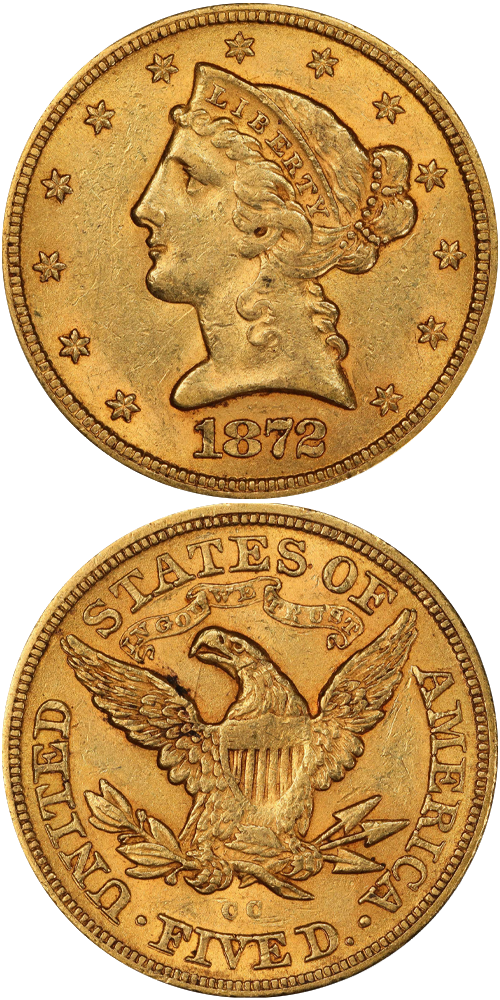1872-CC Liberty Head Half Eagle
Jeff Ambio: The only known obverse die for the 1872-CC half eagle has the date well centered in the field between the truncation of the neck and the denticles. The digits slope down to the right with the 1 noticeably lower than the 2. There are two known reverse dies, with Winter 1-A examples struck from the same reverse as the 1870-CC. On the Winter 1-B variety, however, the CC mintmark is level, relatively low in the field and much closer to the letters VE in FIVE than on coins struck from reverse A.
The 1872-CC (16,980 coins struck) is much rarer than the 1871-CC in all grades and is tied with the 1873-CC as the second rarest Carson City Mint half eagle in high grades after the 1878-CC. Unlike the 1870-CC, 1871-CC and 1873-CC, the 1872-CC is unknown in Mint State.
Rusty Goe: A sudden boom in the mining activity on the Comstock Lode, 15 miles away, in 1871, reminded everyone why the government had granted Nevada statehood back in 1864, and why it had subsequently established a mint in that state's capital. Superintendent H.F. Rice at the Carson Mint enthusiastically expressed in his 1872 annual report to Mint Director James Pollock how "highly gratifying" were the large increases in bullion receipts. Whereas in 1871 monthly ore deposits at the mint of $100,000 would have brought satisfaction, he told the director that 1872's average had risen to $1 million.
Coiner Granville Hosmer struck 6,580 half eagles in the first half of 1872. He and his replacement Chauncey N. Noteware added 10,400 pieces between July and December. From the total mintage figure of 16,980 not one example survives today in Mint State condition.
Q. David Bowers: Of the half eagles produced at Carson City in 1872, Rusty Goe estimates that 125 to 150 exist totally. When I studied the series some years ago I could find no Mint State coins and estimated that just 60 to 90 circulated examples existed.
Over the years collections offered at auction either lacked an 1872-CC or had one in a low grade. The coin in the June 1941 offering of the William Forrester Dunham Collection was called "Strictly Fine." Harry W. Bass, Jr., the most knowledgeable collector of gold coins that America has ever known did a bit better with an AU-53.
The example to the left was sold by Stack's Bowers Galleries in the Fairmont Collection, JBR Set, where it realized $60,000.






